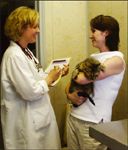Increasing the feline half of your practice
Treating just one species is challenging enough, but veterinarians in general practice must care for dogs and cats every day of the week, and many of these general practitioners consider the following two facts incontrovertible:
Treating just one species is challenging enough, but veterinarians in general practice must care for dogs and cats every day of the week, and many of these general practitioners consider the following two facts incontrovertible:

Dr. Lynn Buzhardt
1.Historically, canine patients (regardless of size) are more agreeable than cats.
2. Cats (regardless of size) are not small dogs.
Cats come with their own set of unique challenges, but veterinarians still want to see more of them in their practices-even the cantankerous ones. Why? Cats are good for business.
For the first time in U.S. history, the number of owned cats has surpassed the number of dogs. As the cat population increases, so does a practitioner's potential for patient volume. Luckily, the average household includes two cats, so veterinarians can increase feline patient loads without dramatically increasing their client bases. In fact, more than 12% of U.S. households own four cats, and these cats see their veterinarians approximately 1.8 times per year. If you take the increase in feline patients, multiply it by the number of annual visits, and factor in the increased expenditures per feline visit over a decade ($44.80 to $92.90), that leaves a fairly optimistic financial outlook for feline medicine. What makes a cat owner choose a general practice over a feline only practice? If the client also owns a dog, he or she may choose a general practitioner for convenience. But more than likely, cat only clients will entrust their feline friends to practitioners who:
1. Serve as cat experts and advocates. Clients often choose a veterinarian based on competence, not price, so general practitioners need to cultivate their knowledge of feline medicine and keep up with advances in feline healthcare. That's the best way to combat the perception that feline-only practices provide better medical care than general practices.

Figure 1. Exam-room communication is one key to a successful veterinary practice.
2. Communicate their ability and desire to treat cats. Don't keep your knowledge and enthusiasm to yourself-tell the owners. It's helpful for veterinarians to speak from personal experience and let clients know that you've "done this before." Owners want to hear about your level of experience with their cat's condition, and they'll feel relieved to learn about the successful outcome of similar cases.
Other steps to successful communication involve illustration and repetition. Discuss medical issues with clients thoroughly and illustrate complicated procedures with diagrams or pictures repeating important information. If client education is the goal, convey your message repeatedly. Instruct your receptionist to begin conversations at the front desk and ask technicians to continue the discussion in the exam room. You'll then reinforce the message when you see the patient (Figure 1). Just make sure the conversations are understandable and not condescending. When clients hear information three times or more, they're more apt to retain it.

3. Exude exam-room confidence. General practitioners who want clients to see them as feline caretakers must refrain from tentative behavior in the exam room. Doctors must destroy the myth that general practitioners are dog doctors who see cats under duress only. They need to approach cats with an equal dose of affection and assertiveness, and just a little dose of fear. Cat owners love their cats, and they want their veterinarians to love them, too. So show your enthusiasm for treating cats-even the unfriendly ones.
An additional reminder: Conscientious cat owners appreciate a friendly greeting when the doctor enters the exam room. Remember to address the cat as well as the owner.
4. Involve the entire staff. Effectively educating receptionists and technicians about the health needs of cats requires consistent instruction from practice owners. Every staff member should be able to fluently discuss immunizations, parasite testing and control, nutrition, reproduction, and infectious disease testing with clients. As the first client contact, receptionists create the initial impression of the clinic. But technicians spend more time with clients, so both must demonstrate friendliness as well as competence.

Figure 2. Appropriate laboratory workups are important aspects of comprehensive preventive medicine programs.
If necessary, raise the priority of staff training in the practice. All staff members, at some point, can lead a discussion, because each employee has some knowledge to impart. Staff members' active participation enhances enthusiasm by showing them the vital roles they play in educating clients.
5. Provide exemplary customer service. Consumers value good customer service, so don't just meet your clients' expectations -exceed them. Face it, clients like receiving the royal treatment, whether it's escorting owners and patients to their cars or providing cardboard carriers to clients with restless cats climbing on their backs. I've even seen one clinic give bottled water (labeled with the clinic's logo) to waiting clients.
You'll also receive high marks for customer service if you keep in touch with cat owners after they visit. Clients appreciate phone calls to check on the progress of a surgical patient, assess the effects of a prescribed antibiotic, or see whether a cat likes its new food. Likewise, congratulatory notes for personal or family accomplishments will build client loyalty, and condolence cards or memorials when a cat dies shows your practice's compassion for the pets in its care.
Customers also appreciate award programs for referring others to the practice. Try printing referral cards and handing them out to satisfied customers. Make the cards the same size as your business or appointment cards and print something on them like, "I'm pleased that Mr. Smith referred me to ABC Animal Clinic. "Then, after three new clients visit the clinic and present his referral card, document the referral program in Mr. Smith's chart and credit his account for a designated amount. New clients appreciate this service, too, and you'll keep building your practice as satisfied clients send in other cat owners.

Figure 3. The animal centers feline health report
6. Maintain a good inventory of feline items. Drop-in shoppers may become loyal clients if you keep the items they need on hand and display them prominently. When clients see that you stock an ample supply of feline items, they'll view the clinic as well equipped to care for their cats in other ways.
7. Offer wellness programs. Preventive medicine is the foundation of comprehensive healthcare and is instrumental in the success of any practice. Cat owners, like dog owners, expect good medical care "in sickness and in health." So enhance your efforts to treat patients from "womb to tomb" by initiating wellness programs for new and existing cat-owning clients.
The best feline wellness programs encompass every stage of a cat's life (kitten, junior, and senior), with clients receiving information on each plan within the appropriate age brackets. Kitten wellness plans should outline the recommended series of physical exams, immunizations, fecal exams, and retrovirus tests on a predated form with itemized fees. Total the fees for each visit and deduct 10% to 15% if clients pay in advance. This shows the client what each visit will entail, increases clinic income, and, most importantly, increases client compliance, which ultimately improves patient care. Many clients won't return for a fourth booster after receiving a rabies tag on the third visit. By paying for all visits in advance, clients are more likely to return. Clinic income increases, despite the discount, because missed visits mean no income at all.
Junior and senior wellness plans should include a complete physical examination and appropriate laboratory profiles (Figure 2). Senior plans may add more extensive laboratory work, electrocardiograms (ECGs), blood pressure monitoring, and radiographs.
All wellness plans should include examination report cards (Figure 3). These forms illustrate different body systems where doctors can indicate normal and abnormal findings and make comments on these findings. The forms can also reflect suggested diagnostic tests and procedures (e.g., dentals), illustrate laboratory results, and document immunizations. Report cards are especially effective when the caregiver is absent during the exam. Spouses, friends, children, babysitters, and great aunts once removed all bring cats to the veterinary clinic, and these middle men can impede effective doctor-client communication.

Figure 4. This exam room in the Cat Clinic of Orange County, Costa Mesa, Calif., includes a cat-size scale, cat art, and a large window in the door that prevents waiting clients (and pets) from feeling claustrophobic.
8. Create a feline-friendly environment. There are myriad ways to make cat owners feel more at home. You can, for example, provide feline-related reading material in the waiting room, along with photographs of staff members or clients with their cats.
Dogs and cats often don't mix well. Many practices have separate entrances for dogs and cats, but if your clinic only has one door and a single waiting room, you can establish appointment blocks to minimize the intermingling of dogs and cats in the waiting room. Some practices schedule dog and cat appointments on different days of the week or at different times of the day (morning vs. afternoon).This requires properly trained staff members and some flexibility because, inevitably, dogs will show up during cat hours and vice versa.
Finally, consider setting up a feline-friendly exam room (Figure 4). Furnish the room with feline-related reading materials, educational tools, treats, and a scale that can weigh small kittens. Just make sure the cat room can adapt easily to dogs as well.
Dog clients should never wait for an available exam room when the cat room is empty.
9. Offer comfortable boarding accommodations. Luxury cat condos are the rage among cat owners, but for general practitioners who don't have the time, money, or inclination to remodel their existing kennels, alternatives do exist. Cats' wants are simple, so you'll make them comfortable by providing adequate room, a variety of substrates, and a little privacy. Start with an ample space that gives cats room to walk around and play and allows you to place their food and water bowls at discreet distances from litter pans. Add some boxes and rugs to sink their claws into. Inexpensive carpet samples are difficult to disinfect and may be discarded, but soft rubber mats are easily maintained and reusable. It also helps to cover cage doors so nervous cats won't have to stare at other cats or, even worse, other dogs.
It's great if you can provide separate kennels for dogs and cats, but if you have only one kennel, avoid the traditional boarding diagram of cats on one side and dogs on the other. Instead, keep cats at the back of the room facing each other, with the dogs at the front of the room. This prevents cats from having to witness a canine parade as attendants lead the dogs outside to eliminate. One final tip: Music actually may soothe the savage beast, so playing a radio in the kennel is an easy, effective addition.
Taking care of dogs and cats is certainly a challenge for general practitioners. Cats may be unpredictable creatures at times, but they do break the monotony of treating a single species. There's never a dull moment when dealing with cats or their owners. Increasing the feline portion of a general practice keeps practice life interesting, and it's good for business, too. Caring for cats is definitely worth the effort.
Dr. Lynn Buzhardt is a small-animal practitioner at The Animal Center Inc. in Zachary, La. A native Southerner, she graduated from Louisiana State University School of Veterinary Medicine in 1980. Dr. Buzhardt has been recognized by the human medical community for her seminars that focus on integrating infants into pet-owning households. She also serves as a spokesperson for media news outlets, lectures to fellow veterinarians, and is a member of the Louisiana Governor's Council for Pet Overpopulation and the American Heartworm Society Board of Directors.